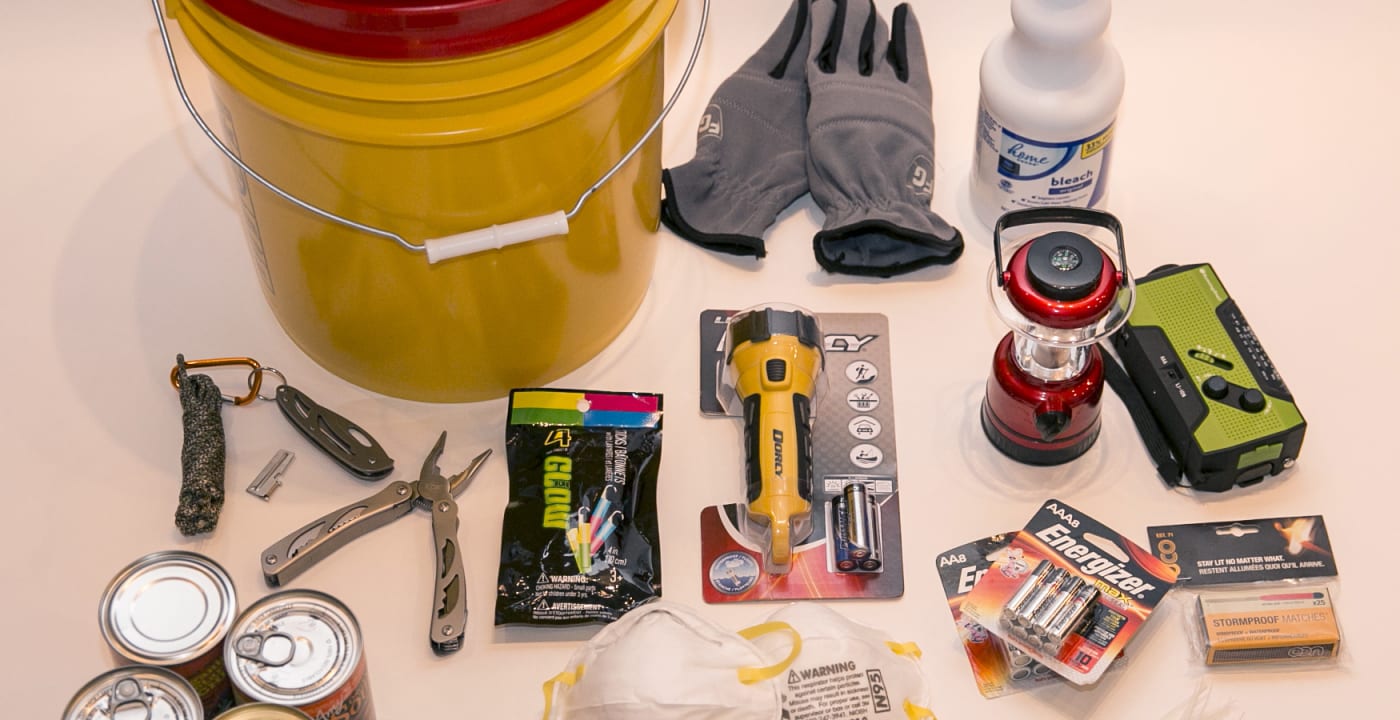DIY preparedness kits: Tips from a Red Cross volunteer

By Roxanne Cooke
For National Preparedness Month, we’re sharing advice from Jeff Pratt, an American Red Cross Disaster Action Team lead who responds to local disasters and emergencies.
He’ll break down what you’ll want in a disaster kit for home, as well as a smaller “pocket kit” you can carry every day.
What to put in a home kit
The home kit assumes you’re sheltering in place, so it doesn’t include items such as cooking pots, blankets, toiletries or water. If you need to evacuate, keep this in mind.
The American Red Cross recommends a kit that can sustain a person or family for 10–14 days.
“When there’s a disaster, emergency services are likely to be overwhelmed,” Pratt says. “It will take time for relief to arrive.” (Hurricane Harvey is a good example of this.)
Here’s what you’ll need:
Non-perishable food: Look for canned/packaged food that (1) is high in protein, (2) can be eaten without being heated and (3) your family will actually eat. A disaster isn’t the time to introduce unfamiliar or disliked foods, if you can avoid it.
LED lantern and/or flashlight: The power will likely be out in a disaster. Multiple sources of light are recommended.
Battery-powered radio: Use this to listen to emergency alerts.
Batteries: Include enough to power your lantern, flashlight, radio and anything else battery operated. Keep them stored separately. It may be tempting to put batteries in ahead of time for convenience, but the batteries will last longer if you don’t.
Glowsticks: Put these at the top of the kit to help you see while you search for what you need. (You’ll need some kind of light to help you find that flashlight and insert the batteries properly.)
Masks: As we’ve all witnessed this past month, ash can be a real concern in Washington. It can come from wildfires, volcanic eruptions or even earthquakes. Look for N95 rated masks and wear them to avoid breathing in dangerous particulate matter.
First aid kit: A small kit is fine if you already have a larger kit stored at home.
Chlorine bleach: Bleach can be used as a water purification tool if you’re unable to boil water — but listen to the advice of local authorities first. To purify, combine 1/4 teaspoon of chlorine bleach with 1 gallon of water and wait 30 minutes before using.
Multi-tool: With a can opener, blade, pliers, file, bottle opener and other tools, this will serve a variety of purposes.
Rope: Use as a clothesline to dry clothing, tie down tarps, make repairs
Work gloves: For cleaning debris, broken glass
Disposable gloves: For sanitation
Zip ties and duct tape: For repairs
Waterproof matches: To start fires for cooking, a heat/light source, signaling
Trash bags: For carrying items, taping over broken windows, wearing as a poncho or simply for garbage
Bucket: Store everything from your kit in a sealable 5-gallon bucket because it’s easy to transport and can be used in emergencies as well, either to carry things or as an impromptu toilet (line with a garbage bag first).
A note about water: The American Red Cross recommends one gallon of water per person, per day. It’s a lot of water, but you’ll need it for hydration, sanitation and hygiene.
Pocket kit for everyday life
If you feel overwhelmed by the thought of creating your own emergency preparedness kit for natural disasters, start out with a pocket kit for daily life.
“The pocket kit is an introduction to what you can carry every day to help you get into a preparedness mindset,” Pratt says.
Stored in a mint tin, the pocket kit fits easily in a purse or bag and houses a surprising amount of stuff:
Rubber bands: These serve double-duty as a preparedness item and to keep your tin’s contents secure.
List of important phone numbers: If your phone becomes unusable and you need to communicate, would you be able to recall the phone numbers of family or friends?
“People are so dependent on their cell phones that most don’t know more than one or two phone numbers,” Pratt says.
Tip: Include an out-of-state contact who could assist in case of natural disaster. Local phone lines often go down during disasters, and you’ll want to be able to reach someone not facing the same difficulties you are.
Magnifying lens: To help you read small print. Could also be used to start a fire, if it’s a sunny day.
Alcohol swabs and bandages
Aspirin
Whistle: To call for help, should you get trapped. It’s more effective than your voice because it can be heard over loud noises — plus, you can really only shout for help for 20 minutes, Pratt says.
Mini flashlight
Waterproof matches and striker/sandpaper: To start a fire or in case your flashlight dies.
Birthday candle: To light things, or to use if your flashlight dies. (And you’ll always be prepared at birthday parties.)
Zip ties
Safety pins: For clothing emergencies.
Compressed hand towel tablets: These tablets turn into small towels — just add water.
Tiny screwdriver: In case your eyeglasses need repair.
Note cards and golf pencil
Emergency cash: For cab fare.



